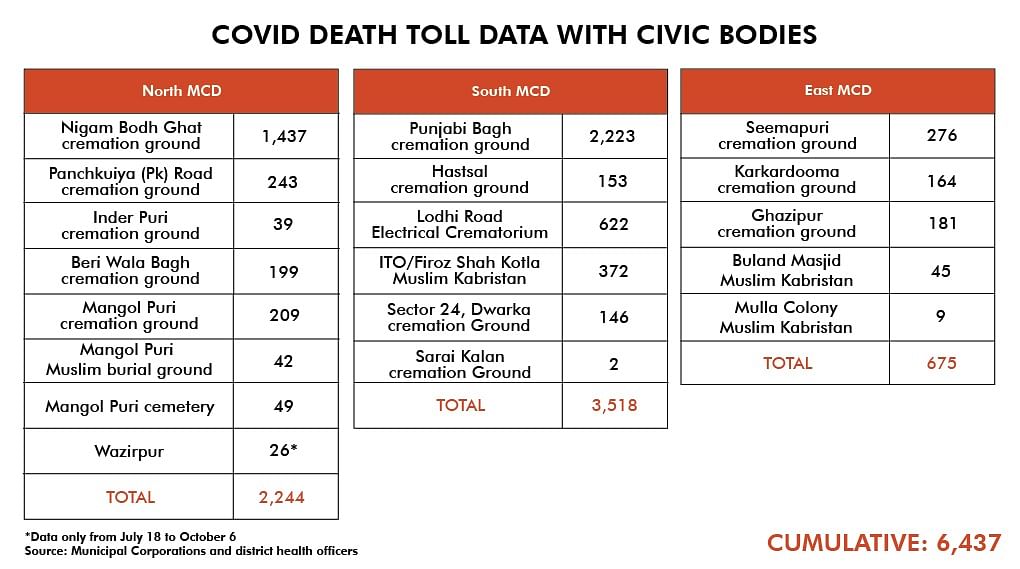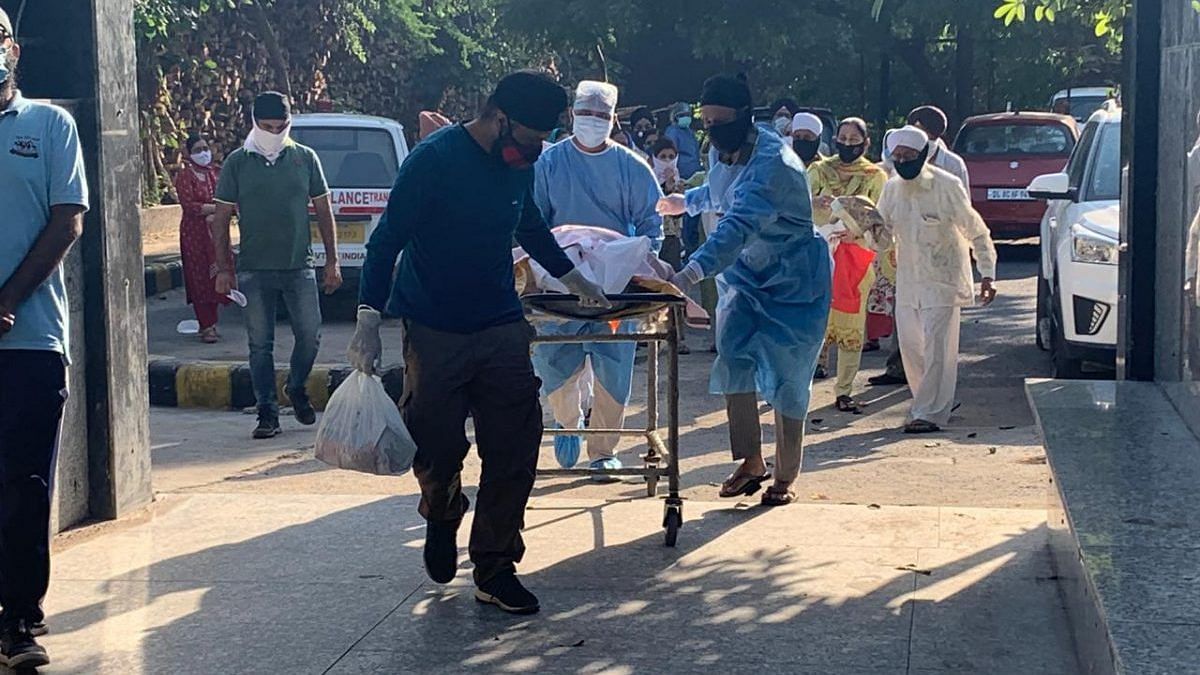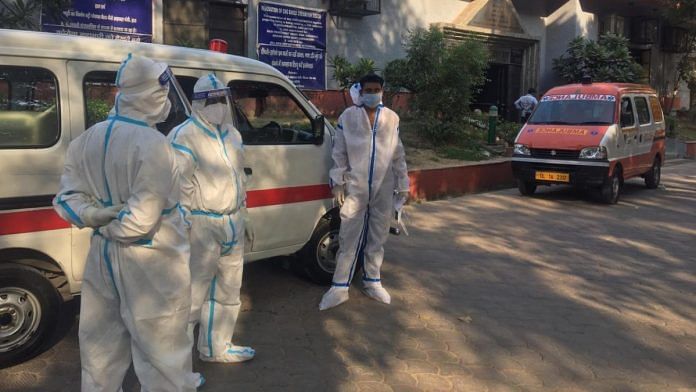New Delhi: The death toll due to Covid-19 in Delhi has been a contentious issue, with there being no real consensus on the figure between the Aam Aadmi Party (AAP) government, the BJP-controlled municipal bodies and burial and cremation grounds across the national capital.
The trend has continued since the beginning of the pandemic.
According to data obtained by ThePrint, the Delhi government has reported 895 fewer deaths than the consolidated figures available with the North, South and East municipal bodies.
The data with the three municipal bodies pegs Delhi’s death toll at 6,437 as of 5 October. The Delhi government health bulletin, however, puts the death toll at 5,542 deaths on the same day.
The data shows that the North MCD recorded a total of 2,244 deaths, the South MCD recorded a total of 3,518 deaths and the East MCD recorded a total of 675 deaths as of 5 October (see box).

This, however, isn’t the first time that discrepancies in Covid deaths have emerged in Delhi.
In May, ThePrint reported how the national capital registered four times the government death figures. Subsequently, in June, ThePrint reported that the five main crematoria in Delhi had conducted double the funerals than the official death toll. In July, ThePrint reported that the Kejriwal government reported 584 fewer Covid-19 deaths compared to the consolidated figures from the civic bodies.
“Now it has also stopped surprising me that there is a discrepancy in numbers reflected by the government in power and the actual Covid-19 deaths since this has been the case from the beginning,” said Jai Prakash, standing committee chairperson, NDMC.
“It is important to let people know the truth so that one doesn’t undermine the gravity of this disease,” the BJP leader added.
ThePrint contacted Delhi Health Minister Satyendar Jain through text, calls and email but he did not respond till the time of filing this report.
A senior Delhi government official, however, told ThePrint that the variation reflects the large number of patients who come from other states for treatment but succumb to the disease in Delhi’s hospitals.
“Delhi government bulletin only reflects deaths of Delhiites. Delhi’s hospitals are full of people from other states who come in a critical condition,” said the official, who did not wish to be named. “When these people succumb to Covid, we obviously don’t send the Covid bodies back to their states but organise their funerals in Delhi itself. That is why there is a variation in the municipal bodies data and Delhi government health bulletin data. We are not hiding anything.”
A senior medical officer, also involved in the process of calculating Covid-19 deaths in Delhi, said, “While there is a margin between the statistics but we must also realise that some bodies also come from Ghaziabad and other periphery towns, so it’s not like Delhi cremation grounds can refuse to cremate those.”
Also read: Bangla Sahib Gurdwara opens low-cost pharmacy, does about Rs 1 lakh business a day
How numbers are arrived at
In order to calculate Covid-19 deaths in the national capital, crematoriums under the three municipal corporations submit data for suspected as well as confirmed deaths to district health officers.
Senior medical officers verify this data along with the total they have received from Covid-19 hospitals. “This way we are able to ascertain the cumulative count for confirmed Covid-19 deaths,” an official involved in the process, who didn’t wish to be named, told ThePrint.
This data is then submitted to the government, which reports the tally in its daily Covid bulletins. As of 7 October, Delhi has recorded a total of 2,95,236 cases with 5,581 deaths and 2,66, 935 recoveries.
Death spike in September
The mismatch in numbers comes amid a sharp increase in Delhi’s death toll. As ThePrint reported, Delhi’s death toll more than doubled through September, rising from 18 on September 1 to 41 on 30 September.
On 29 September, however, Health Minister Satyendar Jain downplayed the rising deaths in the capital. “Delhi reported a large number of cases in September as compared to June. However, the number of deaths reported this month is not even one-third of the fatalities recorded in June,” Jain said.
On 6 October, Delhi Chief Minister Arvind Kejriwal said the capital appears to have passed the second peak.
“Delhi hit the peak of the second wave of Covid-19 on 17 September when 4,500 cases were reported across the city. The situation has been controlled to a large extent,” he said.
Spike shows in crematoriums, burial grounds
The sharp spike in deaths is reflected in Delhi’s crematoriums and burial grounds, where the queues are back. A visit to some of the key crematoriums and burial grounds in Delhi over two days by ThePrint showed that the number of Covid-19 bodies arriving here daily had also increased over the past fortnight.
At Nigambodh Ghat, Delhi’s largest crematorium, ThePrint found two hearse vans waiting for their turn between 12 pm and 3 pm Monday. “I have brought six bodies already today and another one is on the way,” said Sandeep, the hearse van driver for Lok Nayak Jaiprakash Narayan (LNJP) Hospital. The situation was much the same when ThePrint visited between 12 pm and 4 pm Friday. “Most bodies are from LNJP as they have the largest mortuary. I have been bringing an average of 11 bodies everyday through September,” said Rajesh Kumar, another hearse van driver for LNJP Hospital Friday.
Authorities at Nigambodh Ghat, which was under fire for turning away bodies in June, said that while the number of deaths have increased, the situation is not as bad as in the months of May and June. “In August we were getting around two bodies a day but through September we have been getting at least 10 bodies everyday,” said Avdesh Sharma, supervisor, Nigambodh Ghat.
At Punjabi Bagh Cremation ground, which is SDMC’s largest cremation ground, at least 150 people were seen at about 3:30 pm on Monday, most of whom were there for cremations of their relatives or friends.

A priest here, requesting anonymity, said the number of deaths rose from about 2-3 per day in August to 17-18 in the past week and a half. The security guard at the entrance said, “The interval between the number of ambulances arriving in September also reduced. More Covid-19 bodies arrived.”
While 10 Covid-19 bodies were cremated Sunday, at least seven were already cremated as of Monday afternoon at the Punjabi Bagh Cremation Ground.
Similarly, at the Lodhi Road Electric Crematorium, another one of the bigger cremation grounds in South Delhi, six Covid bodies were cremated as of Monday afternoon following eight Sunday.
Dharamvir, who has been a caretaker here for the past 12 years, however, told ThePrint, “The number of deaths are not that different from last year but since we also cremate Covid-19 bodies so the rush is lesser as people are scared.” The caretaker added that the number of daily Covid-19 bodies arriving at the cremation ground increased by four bodies recently.
At the Jadid Qabristan Ahle Islam Cemetery, the largest cemetery in the city, an additional two acres of land was allotted Monday. “There has been a steady increase in burials and we were running out of space so we asked the Committee to allot more land. Through September we have been getting at least five bodies every day, in comparison to the mere one or two bodies that were coming in August,” said Mohammad Shameem, supervisor at the cemetery.
Also read: Only 37% ventilator beds vacant in Delhi, private hospitals say can’t reserve more ICU beds






